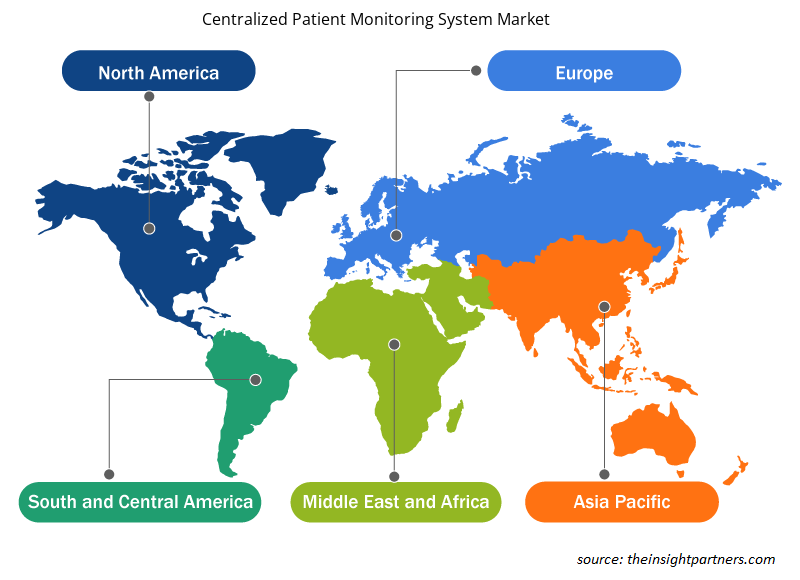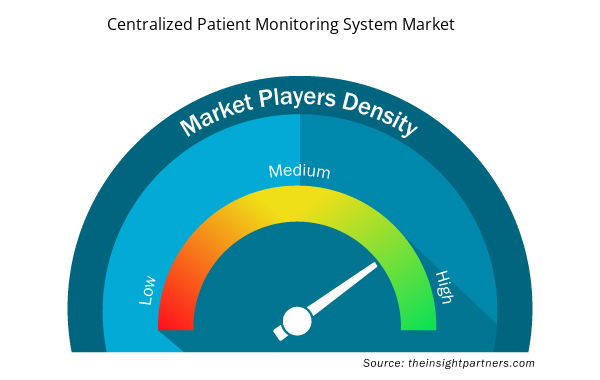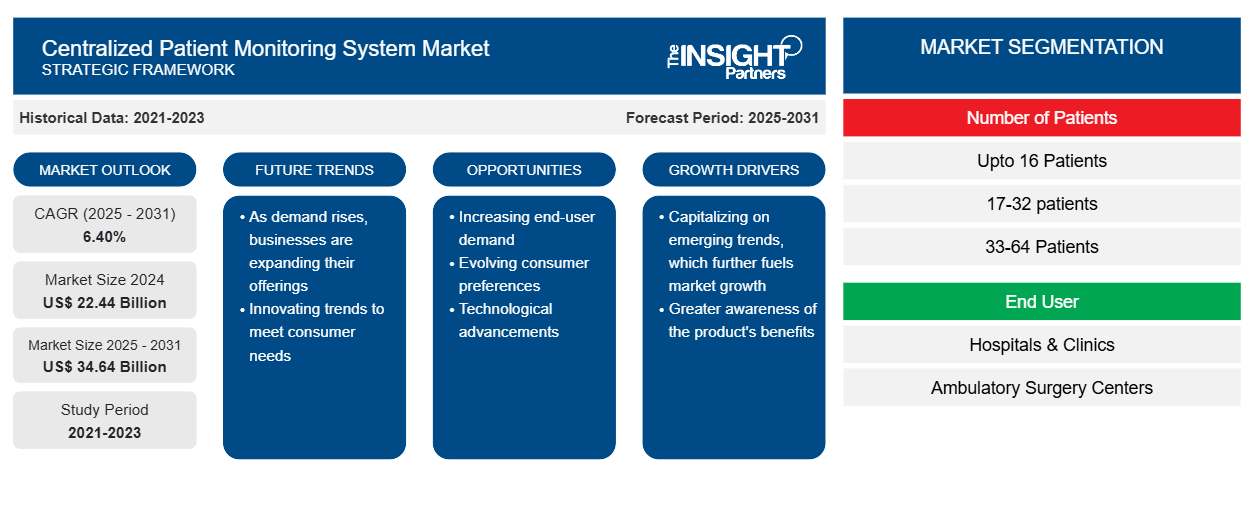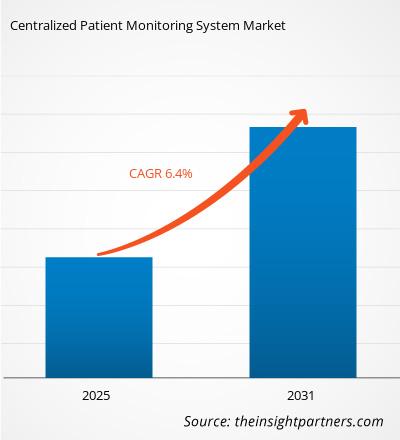[Research Report] The centralized patient monitoring system market size is projected to grow from US$ 19,819 million in 2022 to US$ 32,500 million by 2031; it is estimated to record a CAGR of 6.4% during 2022-2031.
Market Insights and Analyst View:
Centralized Patient Monitoring System facilities provide services to patients to achieve their strength and return home. Patients receive these services after hospitalization for injury, illness, or surgery. In response, hospitals have started developing strategic partnerships with centralized Patient Monitoring System facilities.
Centralized Patient Monitoring System encompasses a broad range of services the patient gets after hospitalization. Sometimes, these services are provided as an alternative to acute care hospitalization, depending upon the type of disease or injury. It could include a stay in an acute care facility, home health care, or continuous outpatient therapy. It all depends upon the seriousness of the disease.
Factors that positively affect the centralized Patient Monitoring System market are the growing prevalence of chronic disease, which boosts the need for a centralized Patient Monitoring System. Also, the strategic partnerships among centralized Patient Monitoring System service providers and the growing elderly population demanding care drive investment in the centralized Patient Monitoring System market.
Customize This Report To Suit Your Requirement
You will get customization on any report - free of charge - including parts of this report, or country-level analysis, Excel Data pack, as well as avail great offers and discounts for start-ups & universities
- Get Top Key Market Trends of this report.This FREE sample will include data analysis, ranging from market trends to estimates and forecasts.
Customize This Report To Suit Your Requirement
You will get customization on any report - free of charge - including parts of this report, or country-level analysis, Excel Data pack, as well as avail great offers and discounts for start-ups & universities
- Get Top Key Market Trends of this report.This FREE sample will include data analysis, ranging from market trends to estimates and forecasts.
Growth Drivers:
Increasing Chronic Diseases
Worldwide, every year, Cardiovascular diseases (CVDs) cause millions of deaths. Heart Disease & Stroke Statistical Update Fact Sheet, Global Burden of Disease, published in 2022, approximately in 2021, 119.1 million people died due to CVDs. It also stated that the global prevalence of ischemic stroke and stroke in 2021 was 68.2 million and 89.1 million, respectively. The major causes of CVDs are obesity, hypertension, and diabetes.
In North America, higher instances of CVDs are observed. As per the National Center for Chronic Disease Prevention and Health Promotion (NCCDPHP) and CDC Division for Heart Disease and Stroke Prevention, around 697,000 people acceded to heart disease in the US, i.e., 1 out of every five deaths. According to the American Heart Association (AHA), by 2035, over 130 million or 45.1% of Americans are likely to get some form of cardiovascular disease. Furthermore, Europe accounts for over 45% of mortality and morbidity due to CVDs and 37% in the European Union (EU).
High blood pressure is the primary risk factor triggering CVDs in low- and middle-income countries, resulting in more than 75% of death cases. As per the study ‘Global Burden of Disease Study 2021,’ CVDs were the leading cause of death in Asia, causing 10.8 million or 35% of the total mortalities.
Hemodynamic monitors allow the measurement of cardiac functions and blood circulation in cardiac patients. The monitoring allows physicians to amount blood pressure from inside the arteries, veins, and heart. Thus, the growing prevalence of cardiovascular diseases is surging the demand for centralized patient monitoring systems.
The rate of obesity among the population is proliferating in developed and developing countries across the world. Obesity in people is increasing primarily due to unhealthy lifestyles and sedentary life. According to the Organization for Economic Co-operation (OECD), in 2021, more than 1.9 billion adults aged 18 years and above were overweight; of these, over 650 million were obese. The number has overgrown in Chile, Australia, the UK, Canada, and South Africa. The obese population is expected to be high in Mexico, the US, and England, consisting of around 39%, 47%, and 35%, respectively, by the next two decades.
Diabetes is affected by the body’s lack of ability to secret insulin and is considered a life-threatening disorder with no cure. This lack of ability prevents the body from adequately regulating blood glucose levels. Diabetes is one of the most substantial diseases of the 21st century. According to the International Diabetes Federation (IDF), in 2021, the total number of diabetic populations in America was 37.3 million, and by 2045, it is expected to rise to 63 million. The increase in the number of people suffering from numerous lifestyle and chronic diseases generates a need for efficient devices and solutions to monitor individual biological limitations under a physician’s consultation, thereby increasing the demand for patient monitoring devices. This is likely to foster the market growth during the forecast years.
Report Segmentation and Scope:
The "Centralized Patient Monitoring System Market" is segmented on the number of patients, end users, and geography.
Based on the number of patients, the market is segmented into upto 16 patients, 17-32 patients, 33-64 patients, and more than 64 patients.
In terms of end users, the centralized patient monitoring system market is segmented into hospitals & clinics, ambulatory surgery centers, and others.
The Centralized Patient Monitoring System market, based on geography is segmented into North America (US, Canada, and Mexico), Europe (France, Germany, Italy, UK, Spain, and Rest of Europe), Asia Pacific (Japan, Australia, China, India, South Korea, and Rest of Asia Pacific), Middle East & Africa (South Africa, UAE, Saudi Arabia, and Rest of Middle East & Africa), and South & Central America (Brazil, Argentina, and Rest of South & Central America).
Segmental Analysis:
Based on end users, the centralized patient monitoring system market is segmented into hospitals & clinics, ambulatory surgery centers, and others. Hospitals & clinics accounted for the highest market share in 2022 and are expected to retain their dominant position over the forecasted period from 2022-2023.
Hospitals are primary contact points for the patients to get their diagnosis done and opt for treatment options and alternatives. Available infrastructure in hospitals is capable of providing high-quality care for any disease condition as they have access to advanced medical devices. The hospital segment is estimated to hold a considerable share as the majority of the patients in emerging nations and developed countries also prefer to visit hospitals for any health-related problem. Each hospital had a central monitoring station that served all of its non-critical cardiac telemetry patients, including those in the selected patient care units.
Further, the growing hospital industry in developing nations is likely to propel the growth of the segment. For instance, as per the IBEF, the Indian hospital industry is expected to grow a CAGR of 16-17% to reach US$ 132.84 billion by 2022 from US$ 61.79 billion in 2017. Additionally, as per the NITI Aayog, Government of India, by 2024, India will have 2,500 new hospitals. Moreover, the increasing hospitals number and the growing ease of access in emerging nations are estimated to offer lucrative opportunities for the growth of the hospital segment during the forecast period.
Regional Analysis:
Based on geography, the Centralized Patient Monitoring System market is divided into five key regions: North America, Europe, Asia Pacific, South & Central America, and Middle East & Africa. North America is likely to capture a significant share of the global market in 2022. The market growth in the region is attributed to the rising investments in cardiology informatics, connected devices, and mobile solutions for advanced cardiac care, increasing product launches, and R&D activities to develop advanced remote cardiac monitoring. In many hospitals across the country, electrocardiograms of multiple at-risk patients are monitored remotely by telemetry monitor watchers in a central location.
The growth of the market is due to factors such as an increase in the demand for remote patient monitoring devices from hospitals & clinics, a rise in the prevalence of cardiovascular disease and home healthcare in the US, and the rise in the geriatric population in the U.S. In addition, the country is far ahead of the other developed and developing countries in terms of technology. The advancement in technology has forced the development of various remote patient monitoring devices and technologies that are used for their applications. However, the veterans in the healthcare industry are reluctant to adopt remote patient monitoring systems, which is restraining the patient monitoring devices market. The companies in the region are growing due to the adoption of strategic steps such as agreements, collaboration, product launches, and many more. For instance, in Jan 2021, NewYork-Presbyterian Hospital and Philips teamed up for remote patient monitoring. NewYork-Presbyterian Hospital has planned to expand its virtual care capabilities with remote monitoring services from Philips. The doctors at Weill Cornell Medicine will utilize the Philips eCareCoordinator and eCareCompanion solutions under hospital affiliation. The use of patient monitoring devices can help to cut chronic disease treatment costs and duration. For instance, coronary artery disease is among the leading cause of morbidity and mortality in well-matured countries. As per the Centers for Disease Control report, one out of four deaths are attributed to coronary artery disease.
The companies in the region are growing due to strategic approaches such as agreements, collaboration, product launches, and many more. For instance, in March 2021, Bardy Diagnostics, Inc., a leading player in ambulatory remote cardiac monitoring technologies, awarded a distribution agreement to JNC Medical, an Ottawa, Ontario-based distributor. JNC Medical will be distributing the BardyDx Carnation Ambulatory Monitor, the industry's first P-wave centric ambulatory cardiac patch monitor, and arrhythmia detection device, in the Canadian market. Owing to the factors mentioned above, the market for patient monitoring is likely to grow in the forecast period.
Industry Developments and Future Opportunities:
Various initiatives taken by key players operating in the global Centralized Patient Monitoring System market are listed below:
- In December 2019, Konica Minolta, Inc. (Konica Minolta) announced that the company will launch VS1, a patient monitoring system, in Japan by the end of 2021 for COVID-19?hospitalized patients with mild to moderate disease who are treated in isolation zones. VS1 makes it possible to send spot-check vital signs of such patients, measured by a pulse oximeter*1, a thermometer, and a blood-pressure monitor, and the patients’ continuous monitoring data with pulse oximeter transmitted to the nurses’ station, located outside the isolation zone via a sub-GHz wireless network, thus enabling collective data management at the station. This system also allows centralized and integrated management of nursing records, such as vital signs obtained from both spot-check and continuous monitoring, for the entire period from the patient’s hospitalization to discharge.
- In December 2022, Mindray launched the mWearTM system, an all-new wearable patient monitoring solution that enables an efficient workflow to monitor patient conditions and deliver advanced patient-centric care continually. Apart from in-hospital patient monitoring, this wearable solution also allows hospitals to extend their care service seamlessly to patients’ homes through the home-hospital App. Its ability to specify continuous medical-grade monitoring for patients at home after discharge has updated the whole patient care process with enhanced safety and flexibility.
- In June 2022, Shenzhen Mindray Bio-Medical Electronics Co., LTD announced that the FDA had reviewed their BeneVision Central Monitoring System for Section 510(k) premarket notification of intent to market. It has been determined the device is substantially equivalent to legally marketed predicate devices.
A centralized remote monitoring solution allows patients to be monitored from the comfort of their own homes. Enhanced Patient Safety: Remote monitoring can improve patient safety by enabling early detection of potential health issues. Various developing and under-developed countries still do not have access to healthcare facilities. The patients from these places must travel a long way to get their routine checkups done by healthcare professionals. Remote patient monitoring and IoT-enabled healthcare devices can help these patients to communicate as well as get diagnosed and monitored by healthcare professionals from their homes, thus saving the time and cost involved in traveling. The expansion of IoT and connected healthcare services in such locations can be a perspective taken into consideration by the major companies operating in the healthcare market.
Competitive Landscape and Key Companies:
Universal Medical Instruments, Philips Healthcare, Criticare Systems Inc, Mediana, MindRay, Infinium Medical, Sunray, GE Healthcare (General Electric), Nihon Kohden, and Baxter International are the major centralized patient monitoring system companies. These companies focus on new technologies, advancements in existing products, and geographic expansions to meet the growing consumer demand worldwide.
Report Scope
Centralized Patient Monitoring System Market Regional Insights
The regional trends and factors influencing the Centralized Patient Monitoring System Market throughout the forecast period have been thoroughly explained by the analysts at Insight Partners. This section also discusses Centralized Patient Monitoring System Market segments and geography across North America, Europe, Asia Pacific, Middle East and Africa, and South and Central America.

- Get the Regional Specific Data for Centralized Patient Monitoring System Market
Centralized Patient Monitoring System Market Report Scope
| Report Attribute | Details |
|---|---|
| Market size in 2023 | US$ 21.09 Billion |
| Market Size by 2031 | US$ 34.64 Billion |
| Global CAGR (2023 - 2031) | 6.40% |
| Historical Data | 2021-2022 |
| Forecast period | 2024-2031 |
| Segments Covered |
By Number of Patients
|
| Regions and Countries Covered | North America
|
| Market leaders and key company profiles |
Centralized Patient Monitoring System Market Players Density: Understanding Its Impact on Business Dynamics
The Centralized Patient Monitoring System Market market is growing rapidly, driven by increasing end-user demand due to factors such as evolving consumer preferences, technological advancements, and greater awareness of the product's benefits. As demand rises, businesses are expanding their offerings, innovating to meet consumer needs, and capitalizing on emerging trends, which further fuels market growth.
Market players density refers to the distribution of firms or companies operating within a particular market or industry. It indicates how many competitors (market players) are present in a given market space relative to its size or total market value.
Major Companies operating in the Centralized Patient Monitoring System Market are:
- Universal Medical Instruments
- Philips Healthcare
- Criticare Systems Inc
- Mediana
- MindRay
Disclaimer: The companies listed above are not ranked in any particular order.

- Get the Centralized Patient Monitoring System Market top key players overview
- Historical Analysis (2 Years), Base Year, Forecast (7 Years) with CAGR
- PEST and SWOT Analysis
- Market Size Value / Volume - Global, Regional, Country
- Industry and Competitive Landscape
- Excel Dataset

Report Coverage
Revenue forecast, Company Analysis, Industry landscape, Growth factors, and Trends

Segment Covered
Number of Patients, End User, and Geography

Regional Scope
North America, Europe, Asia Pacific, Middle East & Africa, South & Central America

Country Scope
This text is related
to country scope.
Trends and growth analysis reports related to Life Sciences : READ MORE..
- Universal Medical Instruments
- Philips Healthcare
- Criticare Systems Inc
- Mediana
- MindRay
- Infinium Medical
- Sunray
- GE Healthcare (General Electric)
- Nihon Kohden
- Baxter International




 Get Free Sample For
Get Free Sample For